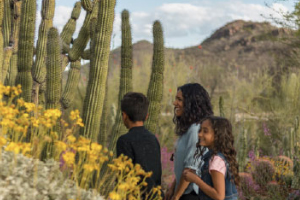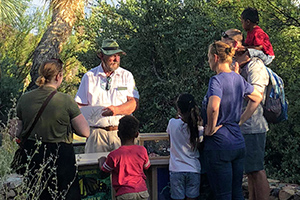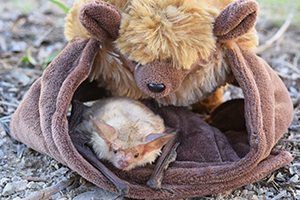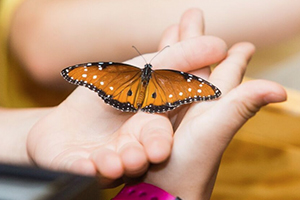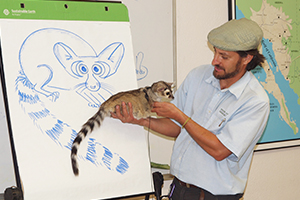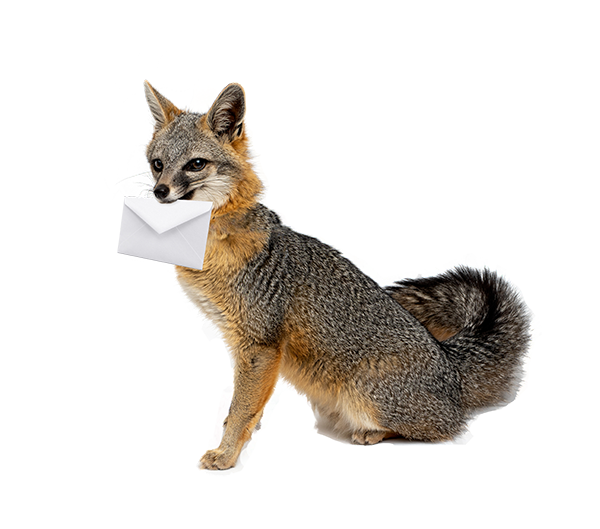Left-over Light
I see that last pothole woke you up. We've just left the Tohono O'odham Nation. I've turned onto this dirt road so that we can park among the creosote bushes and enjoy the closing act in the day's drama of air and light-that unparalleled boon to the photographic industry-a desert sunset.
Balanced on the jagged horizon, the sun has turned the orange color of a desert globemallow blossom. Believe it or not, it looks that way because of the same phenomenon that makes skies, jays, and eyes blue: light scattering. At the end of the day, sunlight travels a much longer path through the atmosphere to reach us than it does at noon. Along the way so much violet, blue, and even green light is "scattered out" that mostly red, orange, and yellow light gets through. In other words, the reddish light we're seeing now is merely the sunlight that's left over after helping to create blue skies for travelers farther west.
The same purity of the air that makes desert skies so blue also helps make desert sunsets so beautiful. There usually aren't enough large aerosols here to quench the light of the setting sun or to reduce visibility. However, smaller aerosols, mainly in the form of airborne dust, can actually intensify the colors of a sunset.
 |
The earth's shadow and the colors of a thundercloud just after sunset. The bottom of the cloud (1) is in darkness. The middle of the cloud (2) is lit by sunlight reddened by scattering in the lower atmosphere. The top of the cloud (3) is white; it's lit by sunlight that has passed only through the rarefied upper air. |
Unlike larger aerosols, which, as you'll remember, scatter light of all colors about equally, very small particles scatter bluer light preferentially, much as air molecules do. They brighten the blue sky and make sunsets even redder. It's because of these tiny particles that desert sunsets are usually more colorful than sunrises. Breezes and dust devils increase the dustiness of air by the end of the day, but some of the dust settles out during the calm of the night. (When you see a dust devil, think of it as a sunset in the making!)
Now the sun has dropped below the horizon, and we need to turn 180 degrees to watch the next important event. A blue-gray band is rising slowly above the eastern horizon. This is the earth's shadow-literally the shadow of our planet on its own atmosphere. From the point of view of any hawks still soaring in this darkened region of air, the sun is below the horizon. Just above the shadow is a band of reddish light. Hawks soaring up there can still see the setting sun. We see the reddish band because reddened sunset light is being scattered back to us by dust in the air.
The curtain of night rises more quickly, then merges into the darkening sky. If this were a cloudy evening, these few minutes would be the most spectacular-a time of shifting shadows and rapidly-changing hues, as fiery sunlight finds its way through openings between the shifting clouds.
Part of the fun of watching a desert sunset a few months from now will
be following the changing appearance of a monsoon thundercloud. As the
sun slips farther below the horizon, the up-tilting shadow of the earth
swallows the cloud from the bottom up. Just above the rising shadow the
cloud is bathed in the warm light of the setting sun, but for many minutes
the top of the cloud remains bright white, because at that great altitude
the air is too thin to appreciably dim and redden the sunlight. Then,
just before it's extinguished, the summit turns pink as it's lit by sunlight
that has passed close to the earth's surface far to the west.

